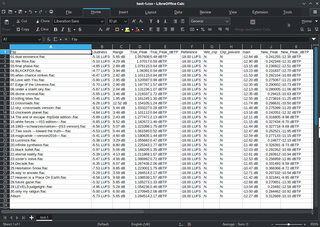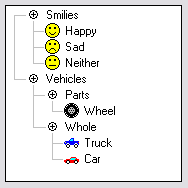
Microsoft Excel is a spreadsheet editor developed by Microsoft for Windows, macOS, Android, iOS and iPadOS. It features calculation or computation capabilities, graphing tools, pivot tables, and a macro programming language called Visual Basic for Applications (VBA). Excel forms part of the Microsoft 365 suite of software.

A spreadsheet is a computer application for computation, organization, analysis and storage of data in tabular form. Spreadsheets were developed as computerized analogs of paper accounting worksheets. The program operates on data entered in cells of a table. Each cell may contain either numeric or text data, or the results of formulas that automatically calculate and display a value based on the contents of other cells. The term spreadsheet may also refer to one such electronic document.

A table is an arrangement of information or data, typically in rows and columns, or possibly in a more complex structure. Tables are widely used in communication, research, and data analysis. Tables appear in print media, handwritten notes, computer software, architectural ornamentation, traffic signs, and many other places. The precise conventions and terminology for describing tables vary depending on the context. Further, tables differ significantly in variety, structure, flexibility, notation, representation and use. Information or data conveyed in table form is said to be in tabular format. In books and technical articles, tables are typically presented apart from the main text in numbered and captioned floating blocks.
In computing, an icon is a pictogram or ideogram displayed on a computer screen in order to help the user navigate a computer system. The icon itself is a quickly comprehensible symbol of a software tool, function, or a data file, accessible on the system and is more like a traffic sign than a detailed illustration of the actual entity it represents. It can serve as an electronic hyperlink or file shortcut to access the program or data. The user can activate an icon using a mouse, pointer, finger, or voice commands. Their placement on the screen, also in relation to other icons, may provide further information to the user about their usage. In activating an icon, the user can move directly into and out of the identified function without knowing anything further about the location or requirements of the file or code.

Comma-separated values (CSV) is a text file format that uses commas to separate values. A CSV file stores tabular data in plain text, where each line of the file typically represents one data record. Each record consists of the same number of fields, and these are separated by commas in the CSV file. If the field delimiter itself may appear within a field, fields can be surrounded with quotation marks.

A graphical widget in a graphical user interface is an element of interaction, such as a button or a scroll bar. Controls are software components that a computer user interacts with through direct manipulation to read or edit information about an application. User interface libraries such as Windows Presentation Foundation, Qt, GTK, and Cocoa, contain a collection of controls and the logic to render these.

In interface design, a tab is a graphical user interface object that allows multiple documents or panels to be contained within a single window, using tabs as a navigational widget for switching between sets of documents. It is an interface style most commonly associated with web browsers, web applications, text editors, and preference panes, with window managers and tiling window managers.
In computing, tabbing navigation is the ability to navigate between focusable elements within a structured document or user interface with the tab key of a computer keyboard. Usually, pressing Tab will focus on the next element, while pressing Shift + Tab will focus on the previous element. The order of focusing can be determined implicitly or explicitly. In general, tabbing is cyclical, not linear, meaning that the tabbing will cycle to the first/last element when it moves away from the last/first element.

Accessibility Toolkit (ATK) is an open source software library, part of the GNOME project, which provides application programming interfaces (APIs) for implementing accessibility support in software.

A tree view is a graphical widget within a graphical user interface (GUI) in which users can navigate and interact intuitively with concise, hierarchical data presented as nodes in a tree-like format. It can also be called an outline view.
A webform, web form or HTML form on a web page allows a user to enter data that is sent to a server for processing. Forms can resemble paper or database forms because web users fill out the forms using checkboxes, radio buttons, or text fields. For example, forms can be used to enter shipping or credit card data to order a product, or can be used to retrieve search results from a search engine.
This article describes the technical specifications of the OpenDocument office document standard, as developed by the OASIS industry consortium. A variety of organizations developed the standard publicly and make it publicly accessible, meaning it can be implemented by anyone without restriction. The OpenDocument format aims to provide an open alternative to proprietary document formats.
The Graphical Editing Framework(GEF) is an Eclipse project that provides framework and end-user components related to graphical applications.

The Yahoo! User Interface Library (YUI) is a discontinued open-source JavaScript library for building richly interactive web applications using techniques such as Ajax, DHTML, and DOM scripting. YUI includes several core CSS resources. It is available under a BSD License. Development on YUI began in 2005 and Yahoo! properties such as My Yahoo! and the Yahoo! front page began using YUI in the summer of that year. YUI was released for public use in February 2006. It was actively developed by a core team of Yahoo! engineers.
Web Accessibility Initiative – Accessible Rich Internet Applications (WAI-ARIA) is a technical specification published by the World Wide Web Consortium (W3C) that specifies how to increase the accessibility of web pages, in particular, dynamic content, and user interface components developed with Ajax, HTML, JavaScript, and related technologies.
A software widget is a relatively simple and easy-to-use software application or component made for one or more different software platforms.

FarPoint Spread is a suite of Microsoft Excel-compatible spreadsheet components available for .NET, COM, and Microsoft BizTalk Server. Software developers use the components to embed Microsoft Excel-compatible spreadsheet features into their applications, such as importing and exporting Microsoft Excel files, displaying, modifying, analyzing, and visualizing data. Spread components handle spreadsheet data at the cell, row, column, or worksheet level.
The PLPAK developers, BE4E, describe it as "The PLPAK is special purpose software package for structural analysis of building slabs and foundations based on the Boundary Element Method". The PLPAK uses the shear-deformable plate bending theory according to Reissner.

Yesod is a web framework based on the programming language Haskell for productive development of type-safe, representational state transfer (REST) model based, high performance web applications, developed by Michael Snoyman, et al. It is free and open-source software released under an MIT License.

jQWidgets is a software framework with widgets, themes, input validation, drag & drop plug-in, data adapters, built-in WAI-ARIA accessibility, internationalization and MVVM support. It is built on the open standards and technologies HTML5, CSS, JavaScript and jQuery. This library is used for developing responsive web and mobile applications. Some developers consider jQWidgets one of the top alternatives to the open-source jQuery UI.












